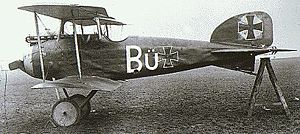Albatros D.I Video - Overview
|
|
Albatros D.I
Albatros D.I

Role: Fighter
Manufacturer: Albatros Flugzeugwerke
Designed by: Robert Thelen
Introduced: 1916
Primary user: Germany
Number built: 50
The Albatros D.I was a German fighter aircraft used during World War I. Although its operational career was short, it was the first of the Albatros D types which formed the bulk of the German and Austrian fighter squadrons for the last two years of the war.
Design and development
The D.I was designed by Robert Thelen, R. Schubert and Gnx¤dig, as an answer to the latest Allied fighters, such as the Nieuport 11 Bébé and the Airco D.H.2, which had proved superior to the Fokker Eindecker and other early German fighters, and established a general Allied air superiority. It was ordered in June 1916 and introduced into squadron service that August.
The D.I used a paneled plywood semi-monocoque fuselage, which was lighter and stronger than the fabric-skinned box-type fuselage then in common use, as well being easier to give an aerodynamically clean shape. On the other hand it was less costly to manufacture than a "full monocoque" fuselage. It was powered by either a 110 kW (150 hp) Benz Bz.III or a 120 kW (160 hp) Mercedes D.III six-cylinder watercooled inline engine. The D.I thus became the most powerful fighter aircraft yet introduced by the Luftstreitkrx¤fte. The additional power enabled twin fixed Spandau machineguns to be fitted without any loss in performance.
The D.I had a relatively high wing loading for its time, and was not particularly manoeuvrable. This was compensated by its superior speed and firepower, and it quickly proved the best all-round fighter available.
Operational history
A total of 50 pre-series and series D.I aircraft were in service by November 1916, replacing the early Fokker and Halberstadt D types, giving real "teeth" to the Luftstreitkrx¤fte's new Jagdstaffeln (fighter squadrons). Further production of D.Is was not undertaken, however; instead, a reduction in the gap between the top and bottom planes in order to improve the pilot's forward and upward vision resulted in the otherwise identical Albatros D.II, which became Albatros' first major production fighter.
Operators
German Empire
Luftstreitkrx¤fte
Specifications (D.I)
General characteristics
Crew: one pilot
Length: 7.40 m (23 ft 3.5 in)
Wingspan: 8.50 m (27 ft 11 in)
Height: 2.95 m (9 ft 8 in)
Wing area: 22.9 m² (247 ft²)
Empty weight: 645 kg (1,422 lb)
Gross weight: 898 kg (1,809 lb)
Performance
Maximum speed: 175 km/h (110 mph)
Endurance: 1.5 hours
Service ceiling: 3,000 m (9,840 ft)
Rate of climb: 2.8 m/s (547 ft/min)
Armament
2 x— forward-firing 7.92 mm (.312 in) LMG 08/15 machine guns
Related development
Albatros D.II
Comparable aircraft
Nieuport 11
Bibliography
Cheesman, E.F. (1960). Fighter Aircraft of the 1914-1918 War. Harleyford Publications.
Munson, Kenneth (1968). Fighters, Attack and Training Aircraft 1914-1919 War. Blndford Press.
Taylor, John W.R. (1969). "Albatros D.I and D.II". Combat Aircraft of the World from 1909 to the Present.. Putman.
Grey & Thetford (1962-70). German Aircraft of the First World War (2nd ed.). Putnam & Company.
Zeppelin-Lindau: D.I
AEG: DJ.I
Albatros D.I Pictures and Albatros D.I for Sale.
Living Warbirds: The best warbirds DVD series.
Source: WikiPedia